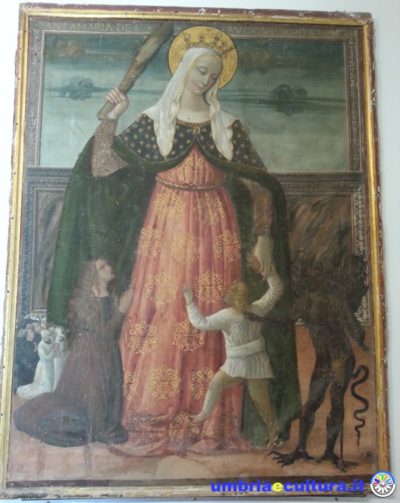Discovering the stunning art of San Francesco Museum in the remarkable village of Montefalco.
Montefalco, the so called railing of Umbria, fills the eyes and regenerates the mind. Park your car and enjoy the beautiful panorama of the Umbrian valley that opens all around, dominated by the green countryside that you will find, almost identical, frescoed by Benozzo, in the apse of the church of San Francesco, recently restored, from where the visit begins.
Already at the entrance, a particular artwork: a large painting of a Madonna with a very sweet face holding in her hand a very knotty club in a threatening attitude… I observe better: she holds a crying child by the hand pulled by a devil while the mother of the child is praying. It is the so-called Madonna del Soccorso, given the high infant mortality and the use of baptizing children in old age in the sixteenth century, this iconography, that depicted the Virgin in the act of saving the child from the devil, following the mother’s prayers, was very common.
The apse of San Francesco church, now part of the Museum of Montefalco, is frescoed by the great tuscan painter Benozzo Gozzoli, with scenes from the life of San Francesco. This work, commissioned to Benozzo from the powerful Franciscan order, was the first created by Benozzo as a Master, after being a pupil of Beato Angelico in Florence. There are many innovations introduced by Gozzoli: the most innovative for the time were the use of perspective and color and the three-dimensionality of the figures.
The cycle is ascending to three registers and culminates with San Francesco in the celestial almond. But see the details on a laid table there is a tart, accompanied by a bottle of the famous Sagrantino wine: it is nice to know that, after all this time, our region is still able to reproduce the same scenes and the same excellences…
About details, painters often adopted a distinctive trait, perhaps a code: Benozzo Gozzoli includes in each scene one or more groups of three stones and Perugino, whose nativity is frescoed at the bottom of the nave, had as a prerogative the fact of not making hooves to animals.
The whole church, originally completely frescoed, reserves further surprises: in the chapel of San Girolamo it is possible to observe in particular the fifteenth-century construction techniques: from the punching of the once golden haloes, to the beaten rope to trace straight lines, to the engraving of the shapes.
Going down to the crypt, and where there was once the ossuary, there is a collection of stone artifacts, including a Latin inscription in the Umbrian alphabet and a remarkable statue of Hercules of the first century a.C.
A very rare example of a stone cellar emerged accidentally during some works in 2006, the hollow where the grapes were pressed, the drains and the collection tanks is still visible. Ancient tools for the processing of wine decorate these rooms, including a small press for Sagrantino, a delicious wine have to be realized according a very strict specification.
In the Pinacoteca: examples of ancient fabrics, another excellence for which Montefalco is renowned, sacred furnishings and vestments, a wooden statue of a Saracino (it seems that the Quintana turnament was disputed also here in Montefalco), the ballot box for the votes for the prior and another Madonna del Soccorso of which here is a version by the Montefalco artist Melanzio.
Remarkable is a work by Antoniazzo Romano made for a Franciscan church and then “recycled” for an Augustinian church. Recycled in a very curious way: by changing the clothes or the prerogatives of the saints by “transforming” them into others, that is: San Francesco (sage, cord and barefoot essays are visible) has turned into San Nicola, shod and dressed in black; Saint Catherine of Alexandria, erasing the wheel symbol of her martyrdom, became Saint Illuminata and San Nicola di Bari becomes San Vincenzo.
There are many curiosities and points of interest in Montefalco, and this wants to be just a taste, for all those who manage to catch and be amazed by all the beauty that surrounds us every day.
Benedetta Tintillini
Find the San Francesco Museum in Montefalco on Google Maps:




